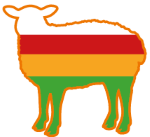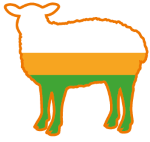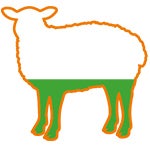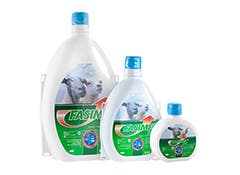A good worm control plan helps your lambs thrive1
You know what a good lamb looks like. But what if good could be better?
The benefits of good worm control
Every farm is slightly different and the quality and quantity of feed available differs - so it's important to make the most efficient use of the feed that's available.

In the 'red zone' where the worm burden is holding lambs back, lambs may end up not finishing and being sold as store lambs.

Even with a moderate worm burden, so in the 'amber zone', 50% of the potential growth rate could be lost on the feed that's available. This might mean that all the feed resources are used by the time the lambs are finished.

If the worm challenge is managed as well as possible, lambs stay in the 'green zone' and grow to their potential on the feed that's available, using that feed more efficiently and finishing before all the feed is used.
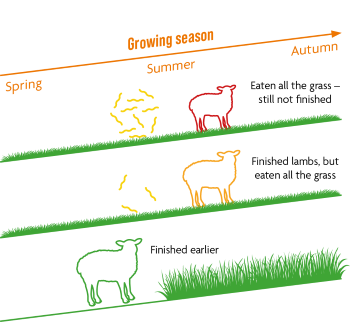
What could YOU do with all the extra grass?
Where does Zolvix fit in?
Every flock, every year preferably before there's a visible problem with the older wormers.
Wormers are an essential part of managing the production-limiting impact of worms, but wormers should be used when there is a demonstrated need rather than as routine treatment programme.
During the bulk of the grazing season, when there is a need to treat, one of the older three groups of actives should be used. On many farms, we can expect these to be less than fully effective in some circumstances so whenever a worming treatment has been given, it's good practice to check its efficacy with a FEC test. The three older groups are:
- the group 1 white drenches (containing for example ricobendazole or oxfendazole);
- the group 2 yellow drenches (containing levamisole) and
- the group 3 clear drenches (containing macrocyclic lactones such as ivermectin, doramectin or moxidectin).
As one of the newer wormer groups, Zolvix, the orange group 4-AD wormer, should be used in every flock, every year for two specific purposes:
- Quarantine treatment for all incoming and returning stock: following the right protocol as is important as using the right product.
- A mid to late season dose for all lambs present at that time (finishing, replacements and stores) in the latter part of your farm's grazing season when a worming treatment is needed - the Break Dose.
Caryl explains how investing in Zolvix has enabled her lambs finish sooner and her costs to be reduced:
"I invest in Zolvix because it keeps my costs down in the long run, the lambs finish quicker - and it's future proofing resistance for the future. Zolvix is worth every penny, because it gives me that peace of mind that all resistant worms are cleared out of those lambs, which means they finish sooner and I get them off to market."
Caryl Hughes, Tuhwntirafon Farm, Llangollen
Using Zolvix as a quarantine dose
Use Zolvix as a farm protection quarantine dose for any stock moving on to the farm. All sheep coming on to the farm are a risk and should be yarded and treated on arrival. This includes both incoming stock and stock coming back on to the farm from a different holding.
There are five elements to quarantine treatments:
- Yard or house animals on arrival to stop them dropping any worm eggs on pasture.
- Choose at least one of the newest groups of wormer to treat - eg Zolvix (4-AD).
- Weigh sheep, calibrate equipment and make sure sheep are drenched correctly. A scab treatment can also be used at this time.
- Continue to hold off from pasture for 24-48 hours to allow the treatment to work.
- Turn out on to dirty pasture – pasture that has carried sheep this season. In addition, a treatment for scab is also advised and SCOPS advises two wormers to be used. For instance if using Dectomax™ for scab control this would also act as a second wormer dose in conjunction with Zolvix.
Neil explains the benefits he's found by using Zolvix in his worming strategy for both a quarantine dose and a mid-late season break dose:
“Having an effective worming programme helps us ensure our lambs continue to grow and meet their target weights, as quickly and efficiently as possible. We’re doing all we can to slow down resistance to all wormer groups, by only drenching when required, breaking the resistance cycle by adding Zolvix into our strategy, and undertaking post-drench efficacy tests to monitor wormer performance. By using Zolvix, our lambs are hitting their target weights quicker and spending less time on-farm, due to them gaining weight more efficiently, making our production costs lower.”
Using Zolvix as a mid-late season break dose
Use Zolvix as a 'break dose' in the mid-late season on your farm sometime after weaning. Timing will vary on individual farms. By the latter part of the grazing season, most lambs will have received wormer treatments involving one or more of the group 1, 2 or 3 products. Any worms resistant to these groups will have survived these treatments and, because they can live inside a sheep for months, they accumulate over the season. This population of worms in the lambs is therefore made up of a higher proportion of anthelmintic resistant worms than the population in refugia when the levels of resistance are low.
Treatment with an effective product, such as Zolvix, will remove these worms and stop them from producing a new generation of resistant worms for the following season. The worm eggs laid later in the season are the ones that overwinter to produce next year’s worms. To get best results, Zolvix should be incorporated into a worm control programme when the level of resistant worms is low4.
Gregor explains how incorporating Zolvix™ into his worm control strategy has managed worm burdens so effectively that his lambs achieve the target growth rates:
“Executing an effective worming programme is vital for us, as it allows us to protect investment already made in our flock, while protecting stock due to be sold the following year. To clear worm burdens around September time, we’ve opted to use an annual late season break dose using Zolvix as part of our worming protocol. It gives us the result that we need to get – which is getting stock thriving and growing again.”
Find out more about managing worms in sheep

Zolvix™
Group 4-AD orange wormer for use as a quarantine or mid-late break dose in sheep/lambs.
- Sutherland et al. The production costs of anthelmintic resistance in sheep managed within a monthly preventative drench program. AgResearch Ltd, The Hopkin Institute and Novartis Animal Health
- Coop et al. 1982 J Agric Sci 98, 247-255
- E.Gascoigne & F. Lovatt. In Practice, 2015 37: 401-414
- SCOPS Internal Parasite Technical Manual



